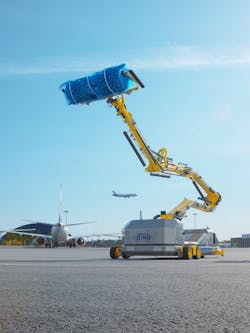How Robots Can Revolutionize Aircraft Cleaning
Aircraft cleaning is a vital aspect of maintenance, ensuring that airplanes not only look their best but also function optimally. However, beneath the exterior lies a challenging task for workers – one that involves significant risks to their safety and well-being. Manual aircraft cleaning demands rigorous physical effort exposes workers to hazardous chemicals, and often requires them to perform tasks at considerable heights.
Luckily, aircraft-cleaning robots are transforming the industry by minimizing the risks associated with manual cleaning processes. Robots are revolutionizing the way aircraft are cleaned, making the process not only more efficient but, most importantly, safer for the dedicated workers in the aviation industry. Jo Alex Tanem, the CEO of Nordic Dino Robotics AB, shares his insights about how exactly robots change daily work and the level of safety for workers.
Eliminating Working at Heights
Cleaning the top surfaces of a large airplane requires personnel to use specialized equipment and sometimes even climb onto elevated platforms. This exposes them to the danger of falls and injuries, as even a minor misstep or equipment malfunction can lead to serious accidents. The risk is further compounded when adverse weather conditions, such as wind or rain, are present.
Aircraft-cleaning robots are equipped with advanced technology that enables them to safely operate at elevated positions, eliminating the need for human workers to engage in such risky activities. Instead of having individuals scale heights, operators can control these robots remotely from a safe and stable location on the ground. This innovation not only ensures the safety of workers but also enhances the overall efficiency and effectiveness of the aircraft cleaning process.
Reducing Chemical Exposure
Manual cleaning of aircraft exteriors typically requires the use of potent cleaning agents and chemicals to remove dirt, grime, and contaminants. While these chemicals are effective at cleaning, they can be hazardous to workers' health. Workers who come into direct contact with these harsh chemicals may suffer from various health issues over time.
Aircraft-cleaning robots play a crucial role in reducing chemical exposure for workers. Robots are designed to handle the application of cleaning agents and chemicals in a controlled and precise manner, minimizing any direct contact between the cleaning substances and human workers. By automating the process of applying cleaning agents, the risk of workers coming into contact with hazardous chemicals is significantly diminished.
Minimizing Physical Effort
Manual aircraft cleaning is a physically demanding job that can take a toll on workers' bodies over time. The repetitive motions, heavy lifting, and constant bending and stretching required during manual cleaning can lead to severe fatigue.
Aircraft-cleaning robots are engineered to perform physically demanding tasks with precision, eliminating the need for human workers to endure such activities. These robots are equipped with specialized tools and arms that can reach high and low areas of the aircraft without effort. By taking over these physically demanding tasks, robots significantly reduce the risk of workers experiencing fatigue or physical injuries.
